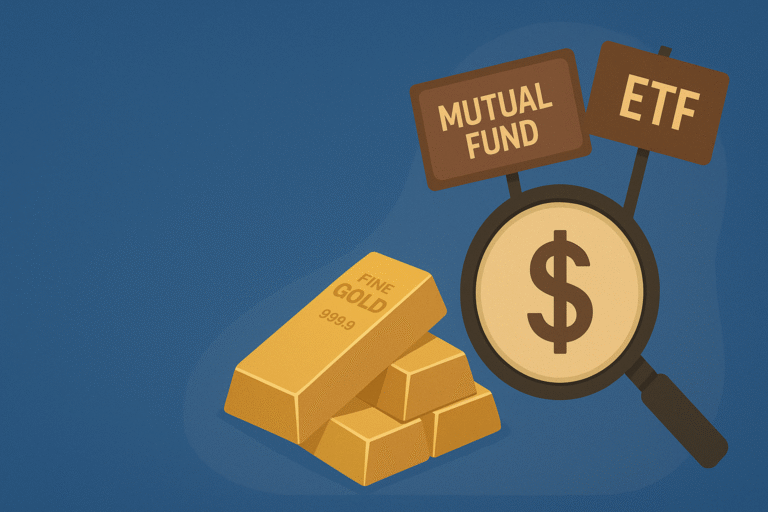Don’t Be Misled by the Lower Expense Ratios of Gold Mutual Funds: Understand the Hidden Costs
By Chetan Wagh | Published: 19 March 2025 | Reading Time: 4 Minutes
Gold has always held a prominent place in Indian households, valued not just for its emotional significance but also as a reliable investment asset.
While SGBs offer excellent long-term benefits, many investors today choose between gold mutual funds and gold ETFs. One crucial yet often overlooked aspect in this decision is the hidden cost investors bear, particularly concerning expense ratios. Let’s explore the true costs behind these two popular gold investment vehicles and clarify what you truly pay for when investing.
What Are Gold ETFs?
Gold ETFs are exchange-traded funds that invest directly in physical gold of high purity. They aim to closely track the price movements of gold and offer investors a convenient, paperless, and cost-effective method of investing in the precious metal.
Key Highlights:
-
Passive investment vehicle
-
Lower expense ratios compared to mutual funds
-
Requires a demat account for transactions
What Are Gold Mutual Funds?
Gold mutual funds are open-ended funds that primarily invest in gold ETFs rather than directly holding physical gold. They pool investor money and route it into gold ETFs managed by the same or affiliated asset management companies (AMCs).
Key Highlights:
-
No need for a demat account
-
SIP (Systematic Investment Plan) options available
-
Ideal for investors looking for ease of access and flexibility
The Hidden Cost: Dual Expense Ratio
When comparing gold mutual funds and gold ETFs, many investors focus solely on the stated expense ratios. Gold mutual funds often advertise lower expense ratios compared to gold ETFs, but there’s more to the story.
Here’s how the hidden cost structure works:
-
Gold mutual funds invest in gold ETFs.
-
Investors pay the expense ratio of the gold mutual fund.
This dual layer of expenses can significantly erode returns over time, something not immediately visible on investment platforms.
Real Data Comparison: Expense Ratios of Gold Funds vs. ETFs
Let’s take a snapshot from leading fund houses as of February 2025:
| Fund Name | Mutual Fund AUM (Cr.) | MF Expense Ratio | ETF AUM (Cr.) | ETF Expense Ratio |
|---|---|---|---|---|
| HDFC Gold ETF FoF | 3,303 | 0.18% | 8,539 | 0.59% |
| SBI Gold Fund | 3,225 | 0.10% | 7,036 | 0.73% |
| Kotak Gold Fund | 2,655 | 0.16% | 6,912 | 0.55% |
| Nippon India Gold Savings Fund | 2,623 | 0.13% | 18,780 | 0.82% |
| ICICI Prudential Regular Gold Savings Fund | 1,741 | 0.09% | 7,081 | 0.50% |
Source: 1 Finance Research
At first glance, the gold mutual fund’s expense ratio seems low. However, investors also bear the cost of the underlying gold ETF, which is significantly higher.
For example:
-
SBI Gold Fund shows a 0.10% expense ratio.
-
Total Expense Ratio: 0.10% + 0.73% = 0.83%
Key Observations from Mutual Fund Factsheets
A closer inspection of gold mutual fund factsheets reveals disclosures similar to:
Examples:
-
ICICI Prudential Gold Savings Fund: Discloses the cumulative expense structure clearly.
Bottom Line: Investors unknowingly pay a higher total expense than they realize.
Comprehensive Expense Ratio Breakdown
| Scheme Name | FoF (Direct) | FoF (Regular) | ETF Expense Ratio | Total Exp. Ratio (Regular) | Total Exp. Ratio (Direct) |
|---|---|---|---|---|---|
| HDFC Gold ETF Fund of Fund | 0.18% | 0.49% | 0.59% | 1.08% | 0.77% |
| SBI Gold Fund | 0.10% | 0.35% | 0.73% | 1.08% | 0.83% |
| Kotak Gold Fund | 0.16% | 0.50% | 0.55% | 1.05% | 0.71% |
| Nippon India Gold Savings Fund | 0.14% | 0.35% | 0.82% | 1.17% | 0.96% |
| ICICI Prudential Regular Gold Savings Fund | 0.09% | 0.39% | 0.50% | 0.89% | 0.59% |
Source: 1 Finance Research
What Does This Mean for Investors?
Paying two layers of expenses leads to a higher cost structure and potentially lower returns.
If maximizing returns is a priority:
-
Additionally, SIP options are not available in ETFs, whereas mutual funds support SIP investments.
What Should You Do?
Gold ETFs remain the most cost-efficient option if:
-
You have a demat account.
-
You’re comfortable managing your investments directly.
Gold Mutual Funds are suitable if:
-
You do not have a demat account.
-
You prefer the convenience of SIPs.
-
You are willing to accept slightly higher costs for easier access.
For those seeking cost efficiency, ETFs make more sense. However, for accessibility and systematic investing, gold mutual funds could still be an option—with the understanding of the dual expense ratio involved.
Conclusion
While gold mutual funds seem attractive with their low published expense ratios, the hidden dual expenses significantly impact your returns. It’s crucial for investors to read factsheets carefully and be aware of all charges before making investment decisions.
If minimizing costs and maximizing gains are your priorities, gold ETFs are a smarter choice. For investors without demat accounts or those seeking systematic investment options, gold mutual funds still offer an accessible route—albeit at a slightly higher total cost.
